Spacepatches.nl - Soyuz TMA-16 Patch
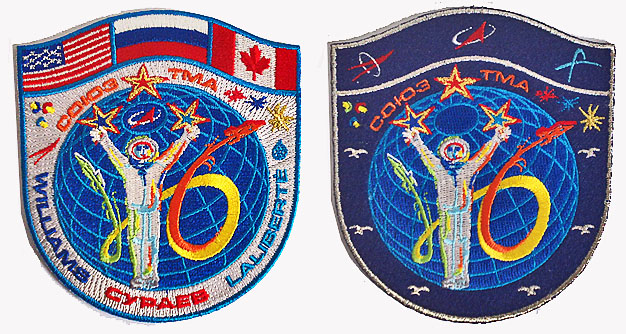
The official Roscosmos Soyuz TMA-16 prime and back-up patches.
The Crew
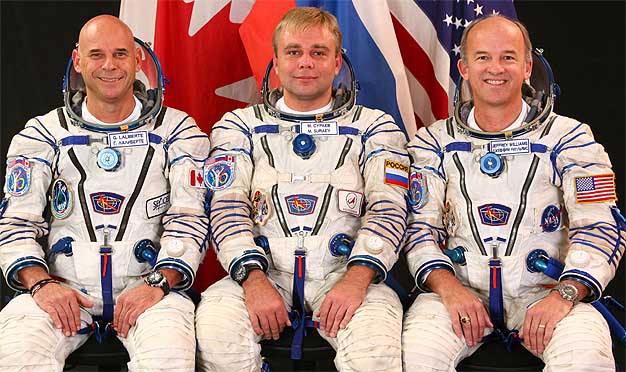
The official crew portrait was taken on August 25, 2009 in Star City. From the left are spaceflight participant Guy Laliberte, Russian Federal Space Agency cosmonaut Maxim Suraev and NASA astronaut Jeff Williams.
The Artwork
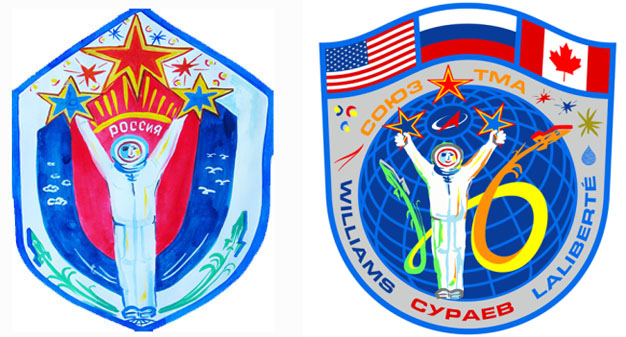
Left: Nastya's drawing. Right: The final artwork was designed by Erik van der Hoorn with input from commander Max Surayev. Copyright: Roscosmos/Spacepatches.nl
The Soyuz TMA-16 patch was based on artwork provided by 14-year old Anastasia Mestyashova from the Orenburg region in Russia.
Central elements are a cosmonaut figure and three large stars, one for each launching crewmember: American astronaut Jeff Williams (dark blue star), Space Adventures participant Guy Laliberte (light blue star) and their Russian spacecraft commander Maxim Surayev (red star). The flags of the cosmonauts' home countries - Russia, the United States and Canada - are shown at the top of the shield.
In the upper left corner, simple shapes symbolize the building blocks of the universe and life on Earh. The 'cradle of mankind', from which the mission originates, is depicted by a growing plant, gradually transforming into a fiery rocket trail and a spacecraft, bound for the International Space Station. The ISS is drawn like a gold star, with 9 rays for each crewmember present when the Soyuz TMA-16 has arrived. The colors of the 6 stars and 3 shapes in the upper left corner, also represent the crew make up. Red for the three Russians, dark blue for the three Americans, light blue for the two Canadians and gold for soon-to-be ISS commander De Winne from Belgium.
The plant and rocket trail together form a '16', the Soyuz TMA mission number. The Earth in the background has the typical grid pattern seen in earlier Soviet and Russian space logo's, heralding all heroes of the Vostok, Woshkod and Soyuz flights of the past. The surnames of Williams and Laliberte are companied by the NASA and One Drop Foundation logo's respectively. In the same area, a small red star and small blue star are included for the future, safe return of Surayev and Williams, who together will land in the Soyuz TMA-16 spacecraft in March 2010.
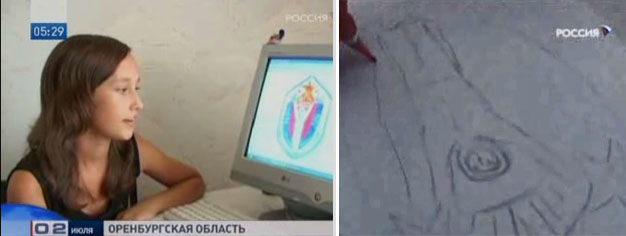
Nastya Mestyashova explains her design on Russian television channel Vesti on July 2, 2009.
Additional designing
Some of the additional elements of the patch date back nearly a year before launch. The '16' shape, ending in the flight path of a spaceship, was first drawn by Erik in October 2008, along with a first, quick computerized sketch. At that time, it was not yet known that the (just initiated) children's competition for TMA-14 would continue for future flights.

Another central feature in the patch - the gridded globe - made its first appearance in a proposal by Jorge Cartes, also in October 2008, for Soyuz TMA-15. Jorge: ,,It's the same globe Soviet and Russian cosmonauts had been using by years on their patches, and I tried to make a tribute to all of them. It seems to be the most popular Earth image for the cosmonauts, in contrast with the very common sea-clouds image that American astronauts like.''
The globe and 16 were combined thanks to Jacques van Oene, who picked up the work for TMA-16 in March 2009. ,,Luc had done TMA-14, Erik was still very busy with TMA-15, so I felt it was my job to do some pioneering work on the TMA-16 project", Jacques explains. Although Jorge's and Jacques' work did not directly lead to a patch, exchanging ideas and skills in this stage turned out to be very useful.

Left: Jorge's TMA-15 proposal. Center: An early sketch of the TMA-16 patch drawn on March 18, 2009, by Jorge at the request of Jacques, with the Roscosmos logo at one of the poles. Right: The design Jacques and Jorge proposed to Roscosmos on March 29, 2009. Aimbetov's name is written incorrectly.
In April, it became clear that Aimbetov would not fly - interrupting Jacques' and Jorge's work. Then, on May 7, 2009, Roscosmos announced that the TMA-16 artwork would again be chosen from their growing batch of children's submissions. Anastasia's drawing immediately stood out. With Jacques and Jorge unavailable at the time, Roscosmos asked Erik to help with the final artwork.
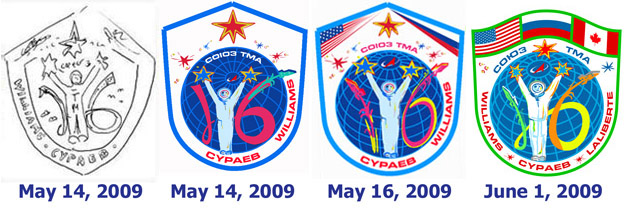
Some stages in the development of the patch.
Because of the international character of the flight, the Russian colors in the background of Nastya's artwork had to go. Instead, a slightly altered version of Jorge's globe was used. The Roscosmos logo was placed in Jacques' prefered position.
The 16 was made up of the shapes that were at the bottom of Nastya's drawing. Because it was unclear if they were rockets or plants, it was decided to use them both ways, to emphasize the connection between spaceflight and Earth. As an additional tribute to Jacques' and Jorge's early work, the 16 was made as colorful as in their proposal.
At the request of commander Surayev, the shape of the large stars was changed and the cosmonaut was given a pair of visible hands. This was done mainly to make it look less like the hands were exploding. Most difficult part turned out to be the border color - at one point, it was green, but in the end, Surayev chose blue and silvery gray.
Official announcement of Guy Laliberte as the third crewmember came on June 4, 2009. The artwork for the patch was formerly approved by Roscosmos head Anatoli Perminov on June 10, 2009. It was made public on June 23, 2009. First images of the embroidered patch were released on July 30, 2009.
All designs copyright Roscosmos/Spacepatches.nl.
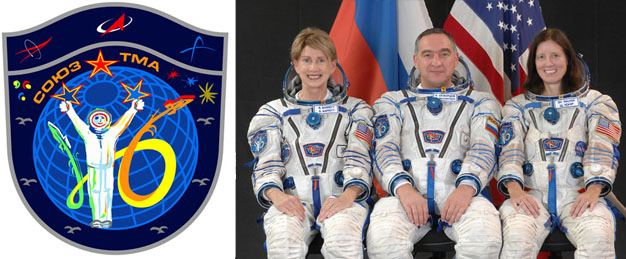
The TMA-16 back up crew: Barbara Barrett, Alexander Skvortsov and Shannon Walker.
For the back up patch, something similar to the TMA-15 back up logo was requested by Roscosmos: a dark background, a bright border but no names and flags, to cover all possible crew make ups. At the suggestion of Roscosmos press chief Alexander Vorobiov the blue and silver border colors of the primary patch were inverted and only the logo's of Roscosmos, NASA and Space Adventures were used. In this design, the four Americans are represented by blue colors, the three Russians by red, the single Canadian by green and the Belgian by gold. To symbolize the entire TMA-16 team (prime and back up crews) six birds from Nastya's original design were added. The patch, like the TMA-15 back up, was embroidered onto a felt background.
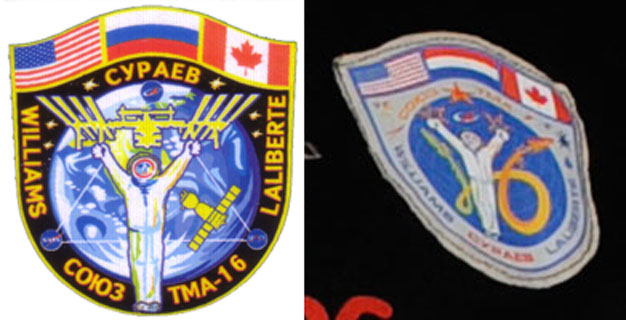
These two 'mutants' of the patch were spotted. At left, is a variant seen on a flown postcard. It was desigend by Sergei Chizhov. The second variation seen here, was flown in orbit with the crew, attached to the White Sun movie poster shirts. These shirts were produced by Laliberte. For some reason, the colors in the Russian flag are switched from white-blue-red to red-white-blue.
The embroidered patches were produced in a one off, single run in July 2009 for Roscosmos and Cirque du Soleil. Roscosmos again kindly allowed us to offer the limited remainder to fellow collectors.
TMA-15 | ISS Index | TMA-17
www.spacepatches.nl









